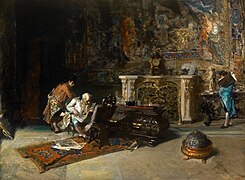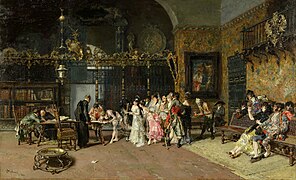Brasero (heater)
This article or section is in a state of significant expansion or restructuring. You are welcome to assist in its construction by editing it as well. If this article or section has not been edited in several days, please remove this template. If you are the editor who added this template and you are actively editing, please be sure to replace this template with {{in use}} during the active editing session. Click on the link for template parameters to use.
This article was last edited by Mcapdevila (talk | contribs) 2 seconds ago. (Update timer) |

A brasero (Spanish: "brazier") is a heater commonly used in Spain.[1] It is placed under a table covered with a cloth that extends to the floor to provide heat for people sitting at the table. This arrangement (which is called a mesa camilla) is similar to the Japanese kotatsu or Iranian korsi. Braseros were traditionally heated with small pieces of charcoal, called cisco or picón; nowadays they are usually electric. Modernly, certain deposits of burning embers, such as the upper compartment of solid fuel heating boilers, are called braseros. [2]

By extension, the term was used to define the place where certain criminals condemned to the stake were executed, [3] generally Jews or infidels victims of one of the most common methods with which the "secular arm" executed those condemned by the Inquisition . [4]
History
[edit]

In several archaeological museums, braseros from Etruria and Rome are displayed. [5] Generally made of bronze, they have quadrangular, circular and oblong shapes; they rest on feet in the shape of wheels or animal claws, or on tripods, and some have rich ornaments in relief. Their use as peveters, in principle, was more religious than thermodomestic. This is also what the examples found in the Iberian Peninsula, of Iberian braseros of segle seem to indicate vii . [6]
Perhaps the oldest precedent of the brasero is an ancestor of the Iranian "korsi", used among other occasions on the occasion of the Persian festival of Yalda. In pre-Columbian America, there are numerous similar artifacts, from the Aztec "tlecaxitl" of religious uses, to the braseros-fireplaces studied by instructor Raúl Ybarra. [7] In Japan there is a similar device, the " kotatsu ". And in South America, especially in the Río de la Plata, a brasero model with barbecue functions is still preserved. [8]
Historic items
[edit]
In the Episcopal Museum of Vic there is a brasero dating back to the segle xiv which nevertheless corresponds to a typology of Romanesque roots or even earlier. [9]
The Barcelona History Museum preserves a pair of large braseros, key pieces of Catalan Baroque metalwork, which were made by the coppersmith Pere Cerdanya in 1675 and which were used to heat the Saló de Cent de la House of the City of Barcelona . [10]
In two of the most important paintings by the Catalan painter Marià Fortuny, . The stamp collector and La vicaria, highlights the prominence of single braseros.
Materials
[edit]
Although the most widespread and traditional brasero was the metal brasero made of different alloys throughout history, [11] there were also several models of ceramic brasero (due to its condition as a pottery object with older precedents ). They used to be open containers, ovoid in shape and with multiple holes. It has often been confused with the portable stove, used to keep the pot of food warm, although this, and especially its embers, could be used as a brasero or to feed it. [12]
Another important chapter is occupied by braseros made of fine chopped stone, many of them in noble stones, common among the remains of the Arab civilization in al-Andalus . [13]
The domestic metal brasero is a concave container usually provided with a lid with cracks through which the heat escapes or, the more modest ones, with a metal wire to avoid burning. To avoid contact with the floor, expensive models included a foot or stand. The fuel par excellence was a type of very small and long-burning charcoal .
The brasero is placed in the center of the rooms or under special tables, called camillas, on a wooden platform perforated in the center to fit it, which also serves as a footrest. To revive the fire a metal instrument is used consisting of a handle and a round paddle, doubly perforated on the upper edge; when the combustion languishes and the heat goes down, it is stirred with the paddle very carefully. For people who spent a lot of time sitting on the camilla, some kind of very uncomfortable spots or blisters appeared on their legs. [15]
Considered a dangerous contraption inside the home due to the fact that it generates embers without being perfectly protected and produces CO, it was the cause of frequent fires, mainly when it came into contact with the skirts of the bunk table and various pieces of clothing of the people However, the most serious danger was the possibility of poisoning due to the emission of carbon monoxide, which occurred especially in poorly ventilated rooms, due to incomplete combustion due to lack of oxygen.
Electric brasero
[edit]In the second half of the 20th century the traditional brasero fell into disuse. Using the traditional cisco/charcoal/pitch brasero required a place to store the coal, a place to dispose of the ashes, and was a very dirty task for a small city dwelling, and with economic development there were who preferred the use of the electric brasero for the convenience of having a plug and even a switch on the cable, which allowed for immediate heat and without coal embers that could generate a fire from a spark or CO poisoning produced by a bad combustion of these.
Currently, there are still people, especially very old people and in villages, who continue to use this type of braseros, and, unfortunately, every year there are many deaths, from fires or from inhaling CO due to poor combustion of the coal or the fire itself by a resistance that becomes red hot in the case of electric braseros and that burns when something comes into contact with it.
It is easy to fall asleep in the heat of the brasero and that the footwear, or some garment, or the so-called "bunkcloth" (there are different names for this, usually thick, coat cloth, with which the bedside table where the braseros are placed), end up unknowingly coming into contact with the brasero, even committing the imprudence of leaving it on (or by forgetting) while falling asleep or out of house, and that the high energy consumption of the brasero generates overheating in the cables, the plug or the table and this "clothing" with which the bunk table is covered to prevent the heat (hot air) from escaping under the table
In some houses, to avoid possible contact with the feet, they put a protection, like a cage, on the brasero, although this did not prevent sparks or poor combustion.
Then another device emerged, which, like electric braseros, has a resistance that heats up with the passage of the electric current, and which is usually known as a "lloret" since they have the shape of a small cage, and are hung under of the top of the bunk table (with average consumption of 450 W). [16]
And finally, to avoid all the risks of the electric brasero (which in cases of forgetting to turn it off end up being a source of fire), and to reduce the energy costs of the electric brasero, which is very high, every day more and more people who choose ecological heaters with very low consumption, which, without losing heat quality, consume less than 100 w. This avoids circulation problems in the legs, fires, high consumption and other damages caused by braseros and which have already been resolved.
In the culture
[edit]Two painters, the Catalan Fortuny in the segle 19th, and Julio Romero de Torres in the first third of the segle xx, they painted beautiful examples of braseros and supports, the fruit of the imagination of boilermakers.
-
Brasero bed, inThe Birth of the Virgin, anonymous oil of the 17thcentury.
-
Brasero with metal support inThe print collector (engravings), painted by Mariano Fortuny (c. 1870).
-
Below, on the left, the large brasero of the Vicar, work by Mariano Fortuny (c.1870).MNAC
-
Large brasero with the Amparo model, oil on canvas painted byJulio Romero de Torres in 1920.
-
:The piconera(1930), one of the last oils byJulio Romero de Torres
Risks using the brasero
[edit]There are some risks attached to the traditional, charcoal-heated brasero. The embers can burn the fabric or the clothes of the users, causing a fire. Given that braseros are covered, combustion can occur with small quantities of oxygen, and instead of carbon dioxide, carbon monoxide can be generated. Carbon monoxide poisoning can kill victims in their sleep, especially in poorly ventilated rooms.
See also
[edit]References
[edit]- ^ Vida y peregrinación: Ministerio de Cultura, 1993. ISBN 8474839432.
- ^ Vida y peregrinación: Ministerio de Cultura, 1993. ISBN 8474839432.
- ^ Execración contra los judíos, escrito de Francisco de Quevedo, publicado en 1633.
- ^ Julio Caro Baroja: Los Judíos en la España moderna y contemporánea. (v.1). Ed. Akal. Obra completa en Ed. Istmo ISBN 84-7090-089-7.
- ^ Francisco Naval y Ayerbe: Arqueología y bellas artes. 1922.
- ^ Jiménez Ávila, F. Javier (2002). "Braseros ibéricos". La Toréutica Orientalizante en la Península Ibérica. Real Academia de la Historia. p. 105 y ss. ISBN 9788495983053.
- ^ Ybarra, Raúl. "Análisis de un hornillo o brasero de orfebrería prehispánico". Biblioteca de Joyería Ybarra. Retrieved 16 de abril de 2012.
{{cite web}}: Check date values in:|access-date=(help) - ^ Diccionario Enciclopédico Abreviado Espasa-Calpe, tomo II. Madrid, 1957.
- ^ "Braser". Museu Episcopal Vic. Retrieved 2017-01-18.
- ^ Extraordinàries! : col·leccions d'arts decoratives i arts d'autor : (segles III-XX) [Catàleg d'exposició al Museu del Disseny de Barcelona]. Barcelona: Ajuntament de Barcelona-Museu del Disseny de Barcelona. 2014. p. 222-229. ISBN 9788498506273.
- ^ Objeto típico de la industria artesana del gremio de caldereros.
- ^ Antonio Caro: Diccionario de términos cerámicos y de alfarería. Agrija Ediciones. Cádiz 2008. ISBN 84-96191-07-9
- ^ Cuadernos de la Alhambra: braseros del Museo Arqueológico y Etnológico de Córdoba.
- ^ Vídeo sobre el uso del brasero. Template:Wayback
- ^ MOLINER, María. Diccionario de uso del Español. Editorial Gredos, Madrid 1994. ISBN 84-249-1344-2 obra completa.
- ^ Una variedad, denominada en Andalucía "el lorito", consiste en una resistencia blindada con un pequeño chasis, protegida por una rejilla, y que se colgaba bajo el tablero de la mesa camilla.
External links
[edit]- Brief photographic documentation (with further web references) Archived 2007-02-08 at the Wayback Machine </link>




